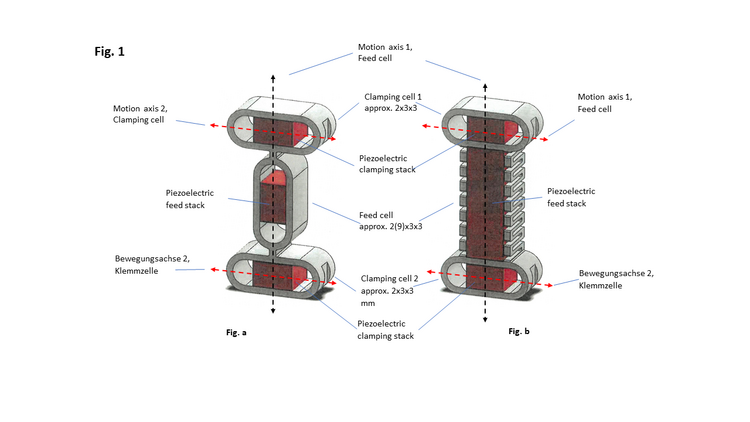Electronic distractor device with miniaturized linear inchworm motor with large actuating force and compact design for medical engineering
Abstract
The innovative piezoelectric inchworm linear motor can be easily miniaturized with a high degree of efficiency and large actuating force and is therefore particularly suitable for use in medical engineering (e.g. as distractor device in orthopedics, orthodontics or cranio-maxillofacial surgeries).
Advantages
- Less fragile and more reliable as no hinges are installed
- Actuation of larger load forces in the range of several tens of newtons (near full capacity of the piezoelectric stack)
- High degree of effectiveness
- More efficient use of the energy conversion as there is no mechanical friction loss during the stroke action
- Miniaturized device with a large load force (e.g. for medical implants)
- Self-clamping at rest
- Small mass/volumes in relation to large load force
Fields of application
Areas of application mainly in the field of medical technology / orthopedics, etc.
Background
The high actuating force of piezo motors is realized using large structural sizes. The piezoelectric linear motors are available on the market in various designs and operating concepts. They are primarily manufactured on the basis of inchworm, stick-slip or ultrasound operating concepts. However, in specific applications such as medical implants compromises need to be found between the miniaturization and actuating force of the motor. Distractor devices are implanted (approx. 6 months) within the body for bone elongation purpose. These are currently operated manually from outside which entails a risk of operating errors and inflammation. For this reason, an electronic distractor device, that is completely implantable, holds numerous advantages. In addition, piezoelectric linear motors are widely used in non-invasive medical engineering, for example in artificial insemination, micromonitoring, nanoliter and microliter pumps and in modern surgical devices.
Problem
Many designs of piezoelectric linear motors or actuators have been published in specialized journals and patents in order to achieve a compact size and a large stroke or high level of mechanical power. Nevertheless, mechanical friction or a high internal mechanical tension involves a major loss of mechanical energy. The shear mode also causes an inefficient mechanical energy transformation of the piezoelectric stack. A further problem is presented by the fragile structures due to the hinges used.
Solution
The innovation by the scientist inventor at Furtwangen University of Applied Sciences is the methodology of integrating and applying piezoelectric stacks within mechanisms based on the mechanical-advantage concept and folded beams. In contrast to the conventional solutions, this invention is not based on embedded or multi-level units which adversely affect the advantages of miniaturization and the low inherent tension, nor on hinges which negatively influence the dynamic reliability. The piezoelectric inchworm linear motor (fig. 1) consists of two clamping cells and one feed cell. When applying voltage, the feed cell extends in the direction of motion axis 1 and the two clamping cells expand in one direction transversely (axis 2) at an angle of 90 degrees towards motion axis 1. The clamping cells can thus create or release an action at both ends. The clamping cells form one monolithic structure with the feed cell. The inchworm motor can be formed from aluminum or stainless steel or titanium. The clamping cells have a height of approx. 2 mm, a width of approx. 3 mm and a length of approx. 3 mm. The feed cell has a height of approx. 2 (or 9) mm, a width of approx. 3 mm and length of approx. 3 mm. The lift resolution lies in the nanometer (Fig. a) to micrometer (Fig. b) range.

